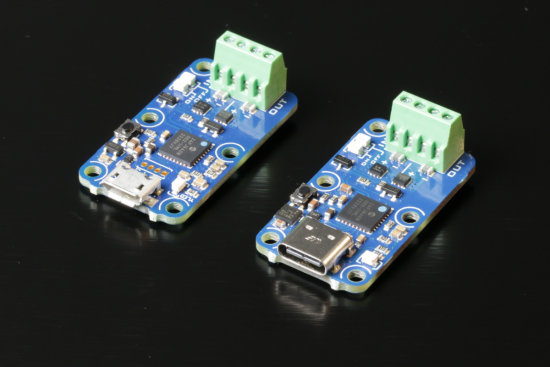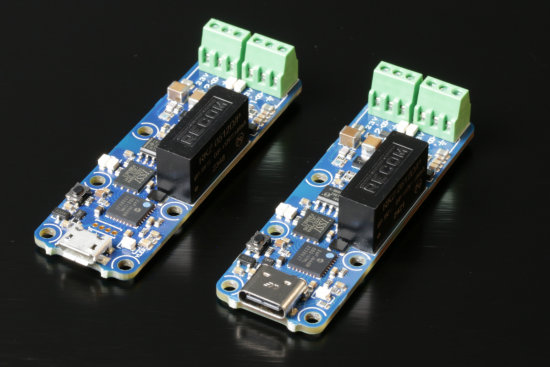![]() Slowly but surely, Yoctopuce is making progress in its transition to modules with USB-C connectivity in place of the Micro-B connectors that seem to be slowly disappearing from everyday life. This week, it's the turn of the Yocto-WatchdogDC and Yocto-4-20mA-Rx modules.
Slowly but surely, Yoctopuce is making progress in its transition to modules with USB-C connectivity in place of the Micro-B connectors that seem to be slowly disappearing from everyday life. This week, it's the turn of the Yocto-WatchdogDC and Yocto-4-20mA-Rx modules.
Yocto-WatchdogDC-C
The Yocto-WatchdogDC-C is the USB-C counterpart to the Yocto-WatchdogDC.

The two versions of the Yocto-WatchdogDC
This watchdog has been designed to automatically reset the power supply of small devices, such as mini-computers. Basically, it contains a timer and a relay, the timer counts down and, when it reaches zero, disables the relay for a few seconds before starting a new countdown. Typically, this is inserted between a mini-computer and its power supply, and a program is run on the computer which, in addition to its normal work, must reset the timer at regular intervals. If the timer reaches zero, something not right at all is happening, and the computer is rebooted - brutal, but highly effective.
The Yocto-WatchdogDC was designed in 2013 at the request of a customer who was having reliability problems with equipment installed in remote places. We didn't expect to sell many, but it's the fourth best-selling module in the Yoctopuce catalog.
The Yocto-4-20mA-rx-C
The Yocto-4-20mA-Rx-C is the USB-C twin of the Yocto-4-20mA-rx.

The two versions of the Yocto-4-20mA-Rx
This module is used to read 4-20mA current loops. This analog transmission technology is little known to the general public, but is widely used in industrial sensor applications. A sensor with a 4-20mA output is powered by two wires and varies its consumption on these wires between 4 and 20 milliamps, depending on what it's measuring. It sounds a bit rustic in this digital age, but it's very reliable and quite accurate. The Yocto-4-20mA-Rx-C is therefore capable of powering the sensor and measuring its consumption, and is even capable of converting between the current flowing through the sensor's power supply and the physical quantity being measured. A significant advantage is that the USB part of the Yocto-4-20mA-Rx-C is isolated from the part that manages the current loop, so there are no nasty surprises if the control computer and the 4-20mA sensor are not at the same potential.
The Yocto-4-20mA-Rx-C is only the tenth best-selling module, but customers who buy it have expressed great interest in a USB-C version, so we've been working on it as a priority.
Where does the price difference come from?
If you're a bit observant, you've already noticed that the price difference between the Micro-B and USB-C versions of the latest Yocto-Light-V5 is just 20 cents.
On the other hand, the USB-C versions of Yocto-WatchdogDC and Yocto-4-20mA-Rx are considerably more expensive than the Micro-B versions.
| Micro-B | USB-C | |||
|---|---|---|---|---|
| Price | year | Price | year | |
| Yocto-Light-V5 | 25.80 CHF | 2024 | 26.00 CHF | 2024 |
| Yocto-WatchdogDC | 22.80 CHF | 2013 | 27.80 CHF | 2025 |
| Yocto-4-20mA-Rx | 85.20 CHF | 2013 | 90.40 CHF | 2025 |
This difference is a direct result of Yoctopuce's pricing policy. In order to maximize profits, it's generally recommended to set the price of a product as high as the amount the average customer is willing to spend with to acquire it. At Yoctopuce, we take a less greedy approach: we determine the unit price of a module by calculating the purchase cost of all its components and multiplying by 3. This price, in Swiss Francs, is calculated when the module is first launched on the market, and is not changed thereafter, except in truly exceptional cases. If you're wondering what the remaining 2/3 of the selling price is used for, after we have paid for the components, it goes to pay salaries, rent, conformity tests, shipping costs, insurance, collection costs, machines maintenance, and so on.
There's another rather Care Bear-like feature of Yoctopuce's pricing policy. When we create a new revision of a product to improve it, we often add components, but avoid passing on the cost increase to the final price. As it happens, these two modules have undergone several revisions since they were first launched.
In short, the prices of the Yocto-WatchdogDC and Yocto-4-20mA-Rx are based on production costs from twelve years ago, whereas the price of the USB-C versions is based on today's costs, which explains the significant difference.
That said, we'll be keeping both versions in parallel for some time to come. If price is more important to you than connectivity, you can continue to buy the micro-B versions.
Conclusion
The migration of Yoctopuce products from micro-B to USB-C is progressing nicely, and the order in which it is carried out depends directly on the interest expressed by our customers in our ongoing survey. So, we can already tell you that next on the list are the Yocto-Volt and Yocto-Thermocouple.


